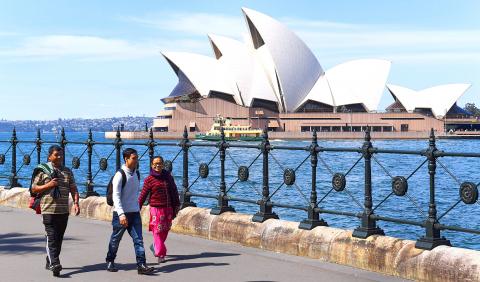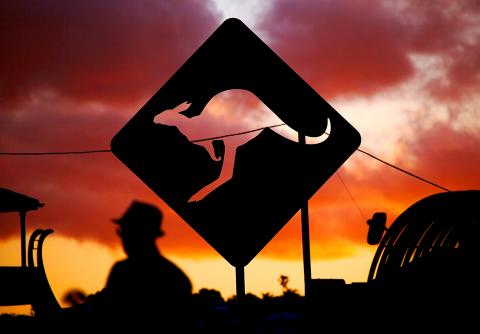Australia needs to step up the quality of its service and accommodation to cash in on a Chinese tourism bonanza, as latest data show it stuck well down global rankings of preferred destinations for visitors from China.
Australia was 17th among worldwide destinations for Chinese tourists on package holidays in the second quarter, lagging behind Russia in 13th place, Vietnam in seventh and leader Thailand, according to the Chinese National Tourism Administration.
The halcyon days of the 1980s and early 1990s — a time when Australia’s economy transitioned to services and the iconic Crocodile Dundee films lured Americans Down Under — seem a distant memory.

Photo: AFP
“Five-star hotels look too old, service is not so good and prices are high for what you get,” said Kevin Xu, general manager of Grand City Tours, which says it is the biggest Chinese travel agent in Australia. “In other parts of Asia, hotels are new and service is excellent. There are also not enough four-star hotels in the Sydney and Melbourne CBDs [central business districts] and in high season they increase prices a lot.”
Xu’s assessment contrasts with the self-congratulation among government and tourism officials when Australia recorded more than 1 million Chinese visitors last year.
The reality is the country is stuck in a 20th-century time warp after diverting investment to the resource industry to cash in on Chinese demand for iron ore and coal.

Photo: Reuters
However, as commodity prices have fallen and China itself transitioned toward a more consumer-oriented economy, Australia once again needs a strong services sector with tourism as its centerpiece.
The country’s pristine coastline, sparkling Sydney Harbor and the vast Outback showcased in actor Paul Hogan’s 1986 comedy Crocodile Dundee proved a magnet for US and Japanese tourists late past century and they remain a major lure for visitors.
In TripAdvisor’s 2016 travelers’ choice awards, Sydney and its opera house still — just — ranked in a list of the top 25 global destinations and landmarks, while Whitsunday Island off the Queensland coast was named the world’s 12th-best beach.
Xu, who has run his company for 22 years, acknowledged that Australia’s tourism bodies have helped ensure there are enough Mandarin speakers available to help Chinese visitors, and cited Queensland’s Gold Coast region as having good facilities and services.
However, that aside, the country needs to do better to really capitalize on China, which is the world’s biggest spender on foreign tourism. Australia’s hotels and resorts and their level of service are nowhere to be seen in TripAdvisor’s roll call of the world’s best.
“We can do a lot more,” said Matt Bekier, chief executive officer of casino and hotel group Star Entertainment Group Ltd. “If you look at Australia’s market share in the flow of Chinese tourists, we’re losing market share. There are more of them going to Switzerland, which is harder to get to and more expensive. Capacity is a big deal. Where do they go? We don’t have the hotel rooms. There’s just not enough capacity here.’’
His concerns on hotel space echo those of Xu.
Tourism Australia has said it recognized about five years ago the need for new, higher-standard hotels and has since been marketing tourism projects to Chinese and Southeast Asian investors.
It has cited Dalian Wanda Commercial Properties Co’s plans to invest about A$2 billion (US$1.5 billion) on Sydney and Gold Coast projects, including hotels and Sunshine Insurance Group Ltd’s purchase of Sydney’s Sheraton on the Park, as success stories.
The Australian Chamber of Commerce and Industry in July said tourism could become the country’s biggest export earner within a decade, but needs sound government policies to help drive the industry.
Tourism could bring in almost A$68 billion by 2025, it cited Tourism Research Australia as saying, from A$39 billion in the year through June.
That is a great opportunity for Australia, Sydney-based HSBC Holdings PLC chief economist Paul Bloxham said.
To give an idea of the potential of China’s outbound travel market, he cited his favorite statistic: that only 5 percent of China’s more than 1 billion people hold a passport.

SEEKING CLARITY: Washington should not adopt measures that create uncertainties for ‘existing semiconductor investments,’ TSMC said referring to its US$165 billion in the US Taiwan Semiconductor Manufacturing Co (TSMC, 台積電) told the US that any future tariffs on Taiwanese semiconductors could reduce demand for chips and derail its pledge to increase its investment in Arizona. “New import restrictions could jeopardize current US leadership in the competitive technology industry and create uncertainties for many committed semiconductor capital projects in the US, including TSMC Arizona’s significant investment plan in Phoenix,” the chipmaker wrote in a letter to the US Department of Commerce. TSMC issued the warning in response to a solicitation for comments by the department on a possible tariff on semiconductor imports by US President Donald Trump’s

The government has launched a three-pronged strategy to attract local and international talent, aiming to position Taiwan as a new global hub following Nvidia Corp’s announcement that it has chosen Taipei as the site of its Taiwan headquarters. Nvidia cofounder and CEO Jensen Huang (黃仁勳) on Monday last week announced during his keynote speech at the Computex trade show in Taipei that the Nvidia Constellation, the company’s planned Taiwan headquarters, would be located in the Beitou-Shilin Technology Park (北投士林科技園區) in Taipei. Huang’s decision to establish a base in Taiwan is “primarily due to Taiwan’s talent pool and its strength in the semiconductor

Industrial production expanded 22.31 percent annually last month to 107.51, as increases in demand for high-performance computing (HPC) and artificial intelligence (AI) applications drove demand for locally-made chips and components. The manufacturing production index climbed 23.68 percent year-on-year to 108.37, marking the 14th consecutive month of increase, the Ministry of Economic Affairs said. In the first four months of this year, industrial and manufacturing production indices expanded 14.31 percent and 15.22 percent year-on-year, ministry data showed. The growth momentum is to extend into this month, with the manufacturing production index expected to rise between 11 percent and 15.1 percent annually, Department of Statistics

An earnings report from semiconductor giant and artificial intelligence (AI) bellwether Nvidia Corp takes center stage for Wall Street this week, as stocks hit a speed bump of worries over US federal deficits driving up Treasury yields. US equities pulled back last week after a torrid rally, as investors turned their attention to tax and spending legislation poised to swell the US government’s US$36 trillion in debt. Long-dated US Treasury yields rose amid the fiscal worries, with the 30-year yield topping 5 percent and hitting its highest level since late 2023. Stocks were dealt another blow on Friday when US President Donald